
Cimarron is a novel by Edna Ferber, published in April 1930 and based on development in Oklahoma after the Land Rush. The book was adapted into a critically acclaimed film of the same name, released in 1931 through RKO Pictures. The story was again adapted for the screen by Metro-Goldwyn-Mayer and was released in 1960, to meager success.

Indian Territory and the Indian Territories are terms that generally described an evolving land area set aside by the United States government for the relocation of Native Americans who held original Indian title to their land as a sovereign independent state. The concept of an Indian territory was an outcome of the U.S. federal government's 18th- and 19th-century policy of Indian removal. After the American Civil War (1861–1865), the policy of the U.S. government was one of assimilation.

The Territory of Oklahoma was an organized incorporated territory of the United States that existed from May 2, 1890, until November 16, 1907, when it was joined with the Indian Territory under a new constitution and admitted to the Union as the state of Oklahoma.
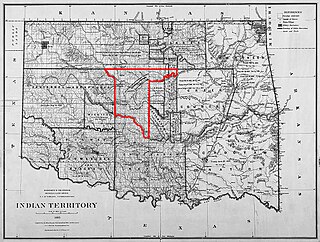
Sooners is the name given to settlers who entered the Unassigned Lands in what is now the state of Oklahoma before the official start of the Land Rush of 1889. The Unassigned Lands were a part of Indian Territory that, after a lobbying campaign, were to be opened to American settlement in 1889. President Benjamin Harrison officially proclaimed the Unassigned Lands open to settlement on April 22, 1889. As people lined up around the borders of the Oklahoma District, they waited for the official opening. It was not until noon that it officially was opened to settlement. The name derived from the "sooner clause" of Proclamation 288 — Opening to Settlement Certain Lands in the Indian Territory, which stated that anyone who entered and occupied the land prior to the opening time would be denied the right to claim land.

David Lewis Payne was an American soldier and pioneer. Payne is considered by some to be the "Father of Oklahoma" for his work in opening the state to settlement.

The Cherokee Outlet, or Cherokee Strip, was located in what is now the state of Oklahoma in the United States. It was a 60-mile-wide (97 km) parcel of land south of the Oklahoma-Kansas border between 96 and 100°W. The Cherokee Outlet was created in 1836. The United States forced the Cherokee Nation of Indians to cede to the United States all lands east of the Mississippi River in exchange for a reservation and an "outlet" in Indian Territory. At the time of its creation, the Cherokee Outlet was about 225 miles (360 km) long. The cities of Enid, Woodward, Ponca City, and Perry were later founded within the boundaries of what had been the Cherokee Outlet.

The Unassigned Lands in Oklahoma were in the center of the lands ceded to the United States by the Creek (Muskogee) and Seminole Indians following the Civil War and on which no other tribes had been settled. By 1883, it was bounded by the Cherokee Outlet on the north, several relocated Indian reservations on the east, the Chickasaw lands on the south, and the Cheyenne-Arapaho reserve on the west. The area amounted to 1,887,796.47 acres.
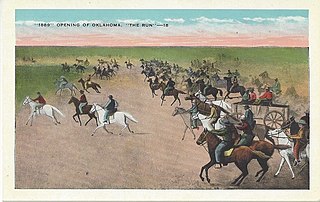
The Oklahoma Land Rush of 1889 was the first land run into the Unassigned Lands of former Indian Territory, which had earlier been assigned to the Creek and Seminole peoples. The area that was opened to settlement included all or part of Canadian, Cleveland, Kingfisher, Logan, Oklahoma, and Payne counties of the present-day US state of Oklahoma.
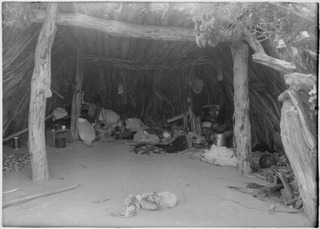
The Kickapoo Tribe of Oklahoma is one of three federally recognized Kickapoo tribes in the United States. There are also Kickapoo tribes in Kansas, Texas, and Mexico. The Kickapoo are a Woodland tribe, who speak an Algonquian language. They are affiliated with the Kickapoo Traditional Tribe of Texas, the Kickapoo Tribe in Kansas, and the Mexican Kickapoo.

The history of Oklahoma refers to the history of the state of Oklahoma and the land that the state now occupies. Areas of Oklahoma east of its panhandle were acquired in the Louisiana Purchase of 1803, while the Panhandle was not acquired until the U.S. land acquisitions following the Mexican–American War (1846–1848).

In U.S. history, the Land Run of 1893, also known as the Cherokee Outlet Opening or the Cherokee Strip Land Run, marked the opening to settlement of the Cherokee Outlet in the Oklahoma Territory's fourth and largest land run. It was part of what would later become the U.S. state of Oklahoma in 1907.
The Land Run of 1891 was a set of horse races to settle land acquired by the federal government through the opening of several small Indian reservations in Oklahoma Territory. The race involved approximately 20,000 homesteaders, who gathered to stake their claims on 6,097 plots, of 160 acres (0.65 km2) each, of former reservation land.
The Texas–Indian wars were a series of conflicts between settlers in Texas and the Southern Plains Indians during the 19th-century. Conflict between the Plains Indians and the Spanish began before other European and Anglo-American settlers were encouraged—first by Spain and then by the newly Independent Mexican government—to colonize Texas in order to provide a protective-settlement buffer in Texas between the Plains Indians and the rest of Mexico. As a consequence, conflict between Anglo-American settlers and Plains Indians occurred during the Texas colonial period as part of Mexico. The conflicts continued after Texas secured its independence from Mexico in 1836 and did not end until 30 years after Texas became a state of the United States, when in 1875 the last free band of Plains Indians, the Comanches led by Quahadi warrior Quanah Parker, surrendered and moved to the Fort Sill reservation in Oklahoma.
The Fort Sill Apache Tribe is the federally recognized Native American tribe of Chiricahua Warm Springs Apache in Oklahoma.

The Land Run of 1892 was the opening of the Cheyenne-Arapaho Reservation to settlement in the U.S. state of Oklahoma. One of seven in Oklahoma, it occurred on April 19, 1892, and opened up land that would become Blaine, Custer, Dewey, Washita, and Roger Mills counties. The land run also opened up what would become part of Ellis County, but was designated County "E" and then Day County prior to statehood.
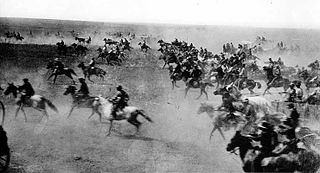
The Land Run of 1895 was the smallest and last land run in the U.S. state of Oklahoma. It came about with an agreement between the Kickapoo people and the federal government that gave individual Kickapoos 22,640 acres (91.6 km2). The federal government purchased the remaining 183,440 acres (742.4 km2) and opened them up to settlers.

"Boomers" is the name used for two groups of settlers in the Southern United States in what is now the state of Oklahoma.
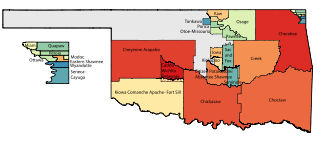
Oklahoma Tribal Statistical Area is a statistical entity identified and delineated by federally recognized American Indian tribes in Oklahoma as part of the U.S. Census Bureau's 2010 Census and ongoing American Community Survey. Many of these areas are also designated Tribal Jurisdictional Areas, areas within which tribes will provide government services and assert other forms of government authority. They differ from standard reservations, such as the Osage Nation of Oklahoma, in that allotment was broken up and as a consequence their residents are a mix of native and non-native people, with only tribal members subject to the tribal government. At least five of these areas, those of the so-called five civilized tribes of Cherokee, Choctaw, Chickasaw, Creek and Seminole, which cover 43% of the area of the state, are recognized as reservations by federal treaty, and thus not subject to state law or jurisdiction for tribal members.

The Cherokee Commission, was a three-person bi-partisan body created by President Benjamin Harrison to operate under the direction of the Secretary of the Interior, as empowered by Section 14 of the Indian Appropriations Act of March 2, 1889. Section 15 of the same Act empowered the President to open land for settlement. The Commission's purpose was to legally acquire land occupied by the Cherokee Nation and other tribes in the Oklahoma Territory for non-indigenous homestead acreage.

An Organic Act is a generic name for a statute used by the United States Congress to describe a territory, in anticipation of being admitted to the Union as a state. Because of Oklahoma's unique history an explanation of the Oklahoma Organic Act needs a historic perspective. In general, the Oklahoma Organic Act may be viewed as one of a series of legislative acts, from the time of Reconstruction, enacted by Congress in preparation for the creation of a united State of Oklahoma. The Organic Act created Oklahoma Territory, and Indian Territory that were Organized incorporated territories of the United States out of the old "unorganized" Indian Territory. The Oklahoma Organic Act was one of several acts whose intent was the assimilation of the tribes in Oklahoma and Indian Territories through the elimination of tribes' communal ownership of property.














